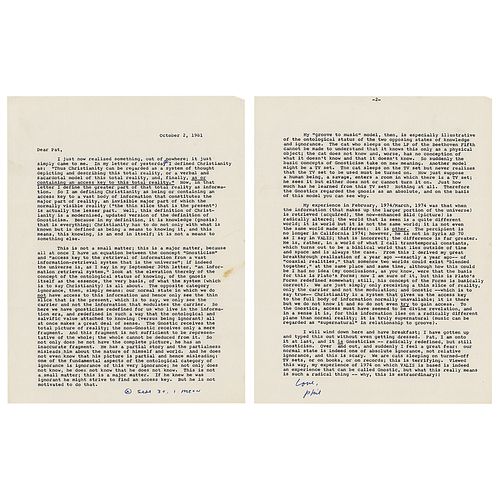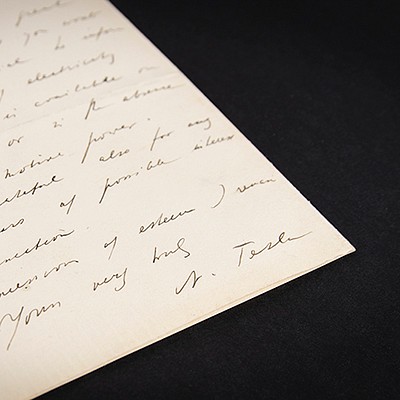Philip K. Dick Typed Letter Signed
Two ways to bid:
- Leave a max absentee bid and the platform will bid on your behalf up to your maximum bid during the live auction.
- Bid live during the auction and your bids will be submitted real-time to the auctioneer.
Bid Increments
| Price | Bid Increment |
|---|---|
| $0 | $5 |
| $50 | $10 |
| $200 | $25 |
| $500 | $50 |
About Auction
Jul 13, 2022
RR Auction support@rrauction.com
- Lot Description
TLS signed “Love, Phil,” two pages, 8.5 x 11, October 2, 1981. Letter to science fiction author Patricia Warrick, in part: "I just now realized something, out of nowhere; it just simply came to me. In my letter of yesterday I defined Christianity as: 'Thus Christianity can be regarded as a system of thought depicting and describing this total reality, or a verbal and sacardotal model of this total reality, and, finally, as or containing an access key to this total reality.' Now, in that letter I define the greater part of that total reality as information. So I am defining Christianity as being or containing an access key to a vast body of information that constitutes the major part of reality ('the thin slice that is the present') is actually the lesser part. Well, this definition of Christianity is a modernized, updated version of the definition of Gnosticism. Because in my definition, it is knowledge (gnosis) that is everything; Christianity has to do not only with what is known but is defined as being a means to knowing it, and this means, this knowing, is an end in itself; it is not a means to something else.
This is not a small matter; this is a major matter, because all at once I have an equation between the concept 'Gnosticism' and 'access key to the retrieval of information from a vast information-retrieval system that is the universe'; if indeed the universe is, as I say in my September 30th letter, 'an information retrieval system,' look sat the elevation thereby of the concept of ontological status of knowing, of the gnosis itself as the essence, the very basis, of what the system (which is to say Christianity) is all about. The opposite category ignorance, then, simply means: our normal state in which we do not have access to this information and hence only see the thin slice that is the present, which is to say, we only see the carrier and not the information that modulates the carrier…
My 'groove to music' model, then, is especially illustrative of the ontological status of the two opposing states of knowledge and ignorance. The cat who sleeps on the LP of the Beethoven Fifth cannot be made to understand that it knows this only as a physical object; the cat does not know and, worse, has no conception of what it doesn't know and that it doesn't know. So suddenly the basic concepts of Gnosticism take on new meaning. Another model might be a TV set. The cat sleeps on the new TV set but never realizes that the TV set to be used must be turned on. Now just suppose a human being, a savage, enters a room in which there is a TV set; he sees it but either does not or cannot turn it on. Just how much has he learned from this new TV set? Nothing at all. Therefore the Gnostics regarded the gnosis as an absolute, and on the basis of this model you can see why.
My experience in February, 1974/March, 1974 was that when the information (that makes up the larger portion of the universe) is retrieved (acquired), the now-enhanced Bild (picture) is radically altered; the world that is seen is a quite different world; it is the same world made different: it is other. The percipient is no longer in California 1974; however, he is not in Syria AD 70 as I say in VALIS; that is incorrect; the difference is far greater. He is, rather, in a world of what I call transtemporal constants, which turns out to be a biblical world that lies outside of time and space and is always the case." In fine condition, with a small stain to the first page. Accompanied by the original mailing envelope.
In the months of February and March 1974, Dick, then still convalescing and medicating himself from an impacted wisdom tooth, began to experience a series of hallucinations. Dick, who referred to them as ‘2-3-74’ in the shorthand, believed that his thoughts were being invaded ‘by a transcendentally rational mind’ of which he referred to as ‘Zebra,’ ‘God,’ or ‘VALIS.’ He documented these experiences in letters to Patricia Warrick. In an interview with Frank C. Bertrand in January 1980, Dick expounded upon his theological philosophy. - Shipping Info
-
Bidder is liable for shipping and handling and providing accurate information as to shipping or delivery locations and arranging for such. RR Auction is unable to combine purchases from other auctions or affiliates into one package for shipping purposes. Lots won will be shipped in a commercially reasonable time after payment in good funds for the merchandise and the shipping fees are received or credit extended, except when third-party shipment occurs. Bidder agrees that service and handling charges related to shipping items which are not pre-paid may be charged to a credit card on file with RR Auction. Successful international Bidders shall provide written shipping instructions, including specified Customs declarations, to RR Auction for any lots to be delivered outside of the United States. NOTE: Declaration value shall be the item’(s) hammer price and RR Auction shall use the correct harmonized code for the lot. Domestic Bidders on lots designated for third-party shipment must designate the common carrier, accept risk of loss, and prepay shipping costs.
-
- Buyer's Premium



 EUR
EUR CAD
CAD AUD
AUD GBP
GBP MXN
MXN HKD
HKD CNY
CNY MYR
MYR SEK
SEK SGD
SGD CHF
CHF THB
THB













